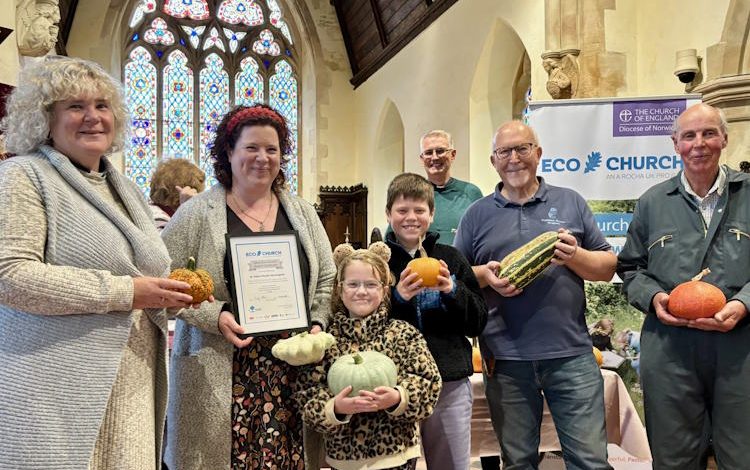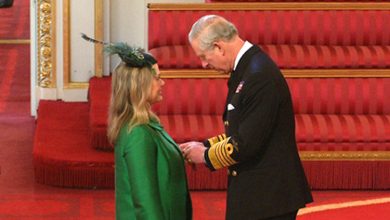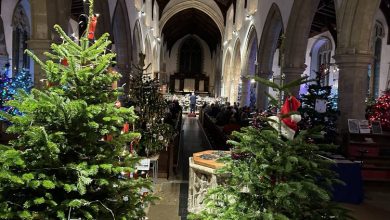Haveringland celebrates Eco Church Silver award

A Celebration of Eco-Stewardship in Rural Norfolk
In the picturesque village of Haveringland, a remarkable celebration unfolded on Sunday, September 28th, as St. Peter’s Festival Church marked a significant environmental milestone. The annual ‘Cut and Rake’ event became the perfect backdrop for commemorating the church’s achievement of the Eco Church Silver award, a testament to their ongoing commitment to environmental stewardship. Around twenty villagers gathered that morning, working together in a spirit of community and purpose, strimming the churchyard and carefully raking away the cuttings. This wasn’t merely a cleanup effort but a deliberate conservation strategy to nurture the churchyard’s meadow habitat and promote biodiversity. After their labor of love, participants enjoyed a well-deserved ploughman’s lunch before gathering for a heartfelt Harvest Festival service. In a touching ceremony, Archdeacon Catherine Dobson presented the coveted Silver Eco Church award to Kate, the church’s Eco Representative, and Nigel Boldero, the Churchwarden, acknowledging their leadership in this green initiative.
The journey toward this environmental recognition has been particularly meaningful for St. Peter’s, which operates under the ‘Festival Church’ model due to the small size of Haveringland village. “We provide a minimum of six services a year, and the people attending these are not necessarily from the immediate area,” explains Churchwarden Nigel Boldero. This unique circumstance presented distinct challenges in building a consistent congregation with whom to engage on sustainability issues. Nevertheless, the church community has shown remarkable creativity in overcoming these obstacles. They’ve organized special events like an ‘Earth Day Festival’ specifically designed to promote environmental awareness and sustainable living practices. Additionally, by working as part of a wider church group, they’ve been able to participate in broader sustainability initiatives that might have been beyond the reach of a single small parish, demonstrating how rural churches can amplify their impact through collaboration.
Perhaps most impressive has been St. Peter’s ambitious approach to improving their historic building while reducing its environmental footprint. Through dedicated fundraising efforts spanning nine years, the church has secured and invested over £500,000 in critical repairs and improvements. These renovations have not only preserved the historic structure but have significantly enhanced its sustainability credentials. Moreover, this investment has laid the groundwork for transforming the building into a Community Hub, expanding its purpose beyond traditional worship. This evolution has been strategically important, allowing the church to engage a broader audience in conversations about environmental sustainability and creating a space where community and conservation values can flourish together, proving that historic buildings can be both preserved and adapted for contemporary environmental challenges.
The church’s commitment to biodiversity extends well beyond the building itself and into the surrounding landscape. Their management of the churchyard as a meadow habitat represents a thoughtful approach to land stewardship, allowing native wildflowers and grasses to thrive and provide essential habitat for pollinators and other wildlife. They’ve enhanced this natural sanctuary by installing bird and bat boxes, creating microhabitats for these important species. A charming addition to their conservation efforts is “Bugingham Palace,” a homemade “bug hotel” that provides shelter for beneficial insects, adding both ecological value and a touch of whimsy to the churchyard. Importantly, St. Peter’s has recognized that effective conservation requires collaboration across property boundaries. They’ve worked with neighboring landowners to plant trees and develop a coordinated approach to nature recovery, demonstrating how local environmental action can build bridges between different parts of a community.
The celebration of the Eco Church Silver award represents not just an environmental achievement but a milestone in community building. The ‘Cut and Rake’ event exemplifies the church’s approach to conservation—practical, participatory, and celebratory. The day brought together people of diverse backgrounds and beliefs united by a shared commitment to caring for their local environment. The presence of Archdeacon Catherine Dobson, who even took a memorable spin on a vintage Ferguson tractor (as captured in photographs shared by the Diocese of Norwich), added both official recognition and a spirit of joy to the proceedings. This blend of serious environmental purpose with community celebration demonstrates how effective conservation work can also strengthen social bonds, creating memories and traditions that sustain both the natural environment and the human community that depends on it.
As St. Peter’s Festival Church looks to the future, their story offers inspiration for other rural churches facing similar challenges of small populations and historic buildings. By reimagining their role as environmental stewards and community connectors, they’ve created a sustainable model that honors their religious heritage while embracing contemporary needs. Their journey from traditional parish church to Festival Church to emerging Community Hub with strong environmental credentials shows how adaptation can preserve relevance and purpose. Those interested in learning more about this inspiring initiative can visit the Haveringland Church and Haveringland Hub Facebook pages or explore the detailed coverage on the Diocese of Norwich website. St. Peter’s exemplifies how faith communities, even in small rural settings, can play a significant role in addressing the environmental challenges of our time while strengthening the social fabric of their communities—proving that care for creation and care for community can beautifully reinforce one another.









mx2pg5
m87nyg
You got a very wonderful website, Glad I discovered it through yahoo.